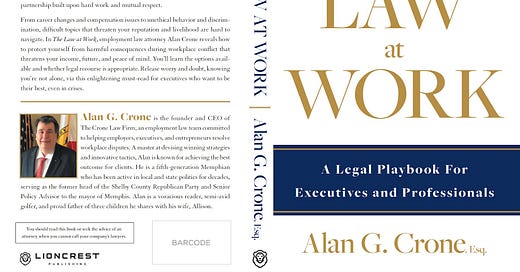As a former HR executive who worked with three healthcare leadership teams, one of my roles was to assist these organizations in steering clear of employment law entanglements. In my daily work, I aimed to create the best win-win scenario for both the employee and employer whenever conflicts arose. Proudly, over the course of my 11 years, none of these organizations was sued for an employment law matter.
In many ways, an employment relationship, as I see it, is sort of like a marriage. As a de facto mediator of sorts, I was often called to listen, acknowledge, and offer support towards resolving conflicts that often arose between employer and employee.
Arguably the diciest case I ever dealt with involved a family practice physician who was employed in a low income health care clinic I worked for years ago. An odd personality and bit unkempt in his attire, this physician was accused of sexual harassment by multiple women at our clinic. After numerous corrective action discussions aimed at getting him to cease the behavior, the decision was made by our executive team to let him go.
Upon consulting with our employment law attorney on retainer, we decided that offering him a severance package tied to a confidential exit agreement was our best option.
I remember the day well, when the Executive Director and I met with him. The vibe was uncomfortable as he walks in and sits at the circular table in the corner of my office. After an awkward pause, I slide the manila envelope over to him that contains the severance agreement and his final check. He opens it, pulls out the agreement, and begins reviewing it with stern attention. After what seemed like an eternity he abruptly arose from his seat, walked out the door with document in hand, hopped into his car, and sped away.
As the Executive Directive and I remained seated at the table in stunned amazement, we both realized that he had neglected to see the final paycheck that was in the manila envelope. “Crap,” I thought. “He’s probably on his way back.” After what seemed like an eternity, I received a call from his wife a few hours later asking if there were any other items of his that she could come by and retrieve on his behalf, which she did. He eventually signed the severance agreement.
This story highlights just one example of how workplace issues can be fraught at times with high drama and uncomfortable exchanges. Because of the inherent employer/ employee imbalance of power, it’s inevitable that scenarios like this will often surface, requiring skill, knowledge, and finesse to bring them to a healthy resolution.
Recently, I was reminded of my years in HR executive roles while reading the book The Law at Work – A Legal Playbook for Executives and Professionals by author and employment law attorney Alan G. Crone.
Crone asserts that myriad factors in a workplace relationship can lead to a bubbling up of disharmony and conflict, situations that require skillful attention and action. Failure to adequately address an issue, he says, cannot only threaten the reputation and livelihood of the employee, but potentially damage the good standing of employers, particularly if they find themselves embroiled in a major lawsuit.
This book in my view is a must read for those seeking a better understanding of how to prevent and resolve twelve of the most common workplace issues Crone lays out. Whether you are an employee, executive, or entrepreneur, it serves as a useful guide for steering clear of legal entanglements that can erode one’s career future, income, and mental health.
In terms of the book’s primary intent, he had this to say:
“The Law at Work” is primarily directed towards executives and professionals who encounter legal issues at work. High ranking executives and successful professionals ironically often have no one to turn to when their work environment is threatened. Often, they do not want to air their dirty laundry to family and friends. They certainly cannot talk to subordinates. Even when they work for a large corporation or institution such resources are often out of reach. HR works for the company, practice, firm, or institution, and the corporate lawyers have a conflict of interest giving legal advice about employment law questions.”
He says that he wrote the book so that folks could get the basics about employment law and the common issues executives and professionals encounter.
“While not exhaustive, the book does provide a number of starting points and terminology for people who want to do a little research on their own before they seek out professional legal help. I wrote the book in a style, tone, and language that non-lawyers could understand and apply the concepts to their unique situation.”
Asked for some of his thoughts about some of the biggest misconceptions employers and workers have about the concept of employment at will, he had this to share:
“Intellectually, most of my clients, both individuals and companies, understand the concept of employment-at-will. However, many still believe that employees have more rights than they do. They hear stories about lawsuits and successful verdicts or settlements, and assume that if something shocking and unfair happens to them, then there is legal recourse. Of course, that is not always the case. Employers certainly have the upper hand. If more employers were transparent and honest about performance issues, then there would be fewer terminations and lawsuits.”
Crone notes that there are three emerging employment law trends that he is keeping a close eye on of late? They are:
Remote Work Impacts
“Working at home or away from the office is by far the most important new employment law trend. It has so many ramifications. Staffing levels are different with remote work. Control/supervision strategies change. Compensation ramifications from tracking work time, overtime, time management, and regional compensation differences may be reduced or eliminated.”
The Federal Executive Branch and its Impact On Employment Law
“The Biden Administration is taking employment to new areas via Executive Order and Agency regulations. Historically, the Executive Branch of the Federal Government by and large stays out of employment law substantive changes. Over the last 30 years or so, various Administrations have begun to make regulatory changes. For example, the Department of Labor could increase eligible overtime salary limits in a new “Proposed Overtime Rule” that is scheduled to be published in May 2023”
Changes in Worker Rights
“Recently, Trump and Biden have both used regulatory authority and agencies to change, advance, or reverse workers’ rights. For example, the Biden Administration asked the Federal Trade Commission to ban or limit non-compete agreements in 2021 as part of a wider effort to improve competitiveness for workers that could impact 30 million people. The public review of this proposal has been extended to April 19, 2023
Offering some additional thoughts on this latter theme of non-compete agreements, Crone add:
“Democrats in Congress and the Biden Administration want to supersede state laws and reduce or eliminate restrictive non-compete agreements. In my opinion, such efforts will be ineffective because these laws are inherently state law creatures. Along with 99% of these agreements being non-enforceable, the biggest problem is that most people do not have the resources to defend against them. It can take tens of thousands of dollars to defend an action against seeking to enforce a non-compete or restrictive covenant.”
Another issue that’s capturing the attention of employers these days are the challenges they face in attracting and retaining worker talent. Here are his thoughts on that front:
“Workers today, no matter their income, job or professional level, want more than just a paycheck. Workers want some sense of purpose, a clear role, and support from people where they work. When a company cares more about its culture and teams than its profits then the latter will take care of itself.”
In closing, Crone says that there are three musts for employers seeking to close this recruitment and retention gap:
Have a Mission
“Companies with a mission will recruit and retain the best employees. If a company recruits, trains, and empowers employees to accomplish a certain mission, those employees will be motivated and invested in the mission and make it their own calling. Who gives up their personal mission for a little more money? No one.”
Have Values
“Articulate and promote your values. Again, hire folks who share and embody those values. Train, promote, and eliminate people based on how well they embody those values.”
Have Fun
I am not talking about foosball in the hallways, but making working enjoyable. Team members should get real joy from doing their jobs. We say all the time “pursue your passion.” If people are passionate about your mission, then it should be enjoyable (fun) for them to come to work and practice their passion.
A Note From Diamond-Michael Scott:
“Great Books, Great Minds” is my full-time work and life passion, a labor of love fueled by the endless hours of work I put into researching and writing these feature pieces. So if you enjoy this digital newsletter, find it valuable, and savor world-class book experiences featuring epic authors and book evangelists, then please consider becoming a paid supporting member at $6.00 a month or $60.00/year.







Thanks Diamond for the outline of this book, I am adding this to my reading list.